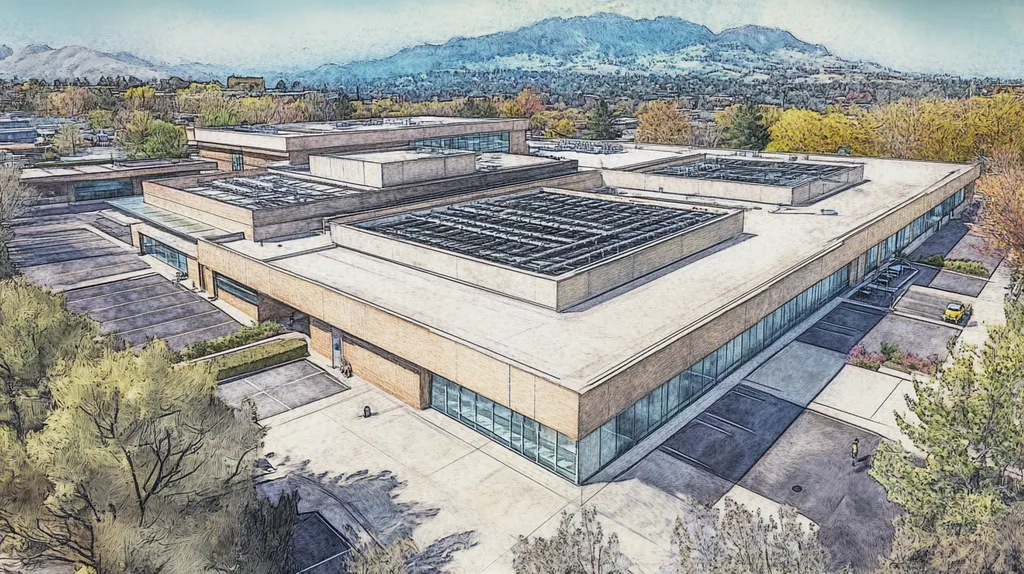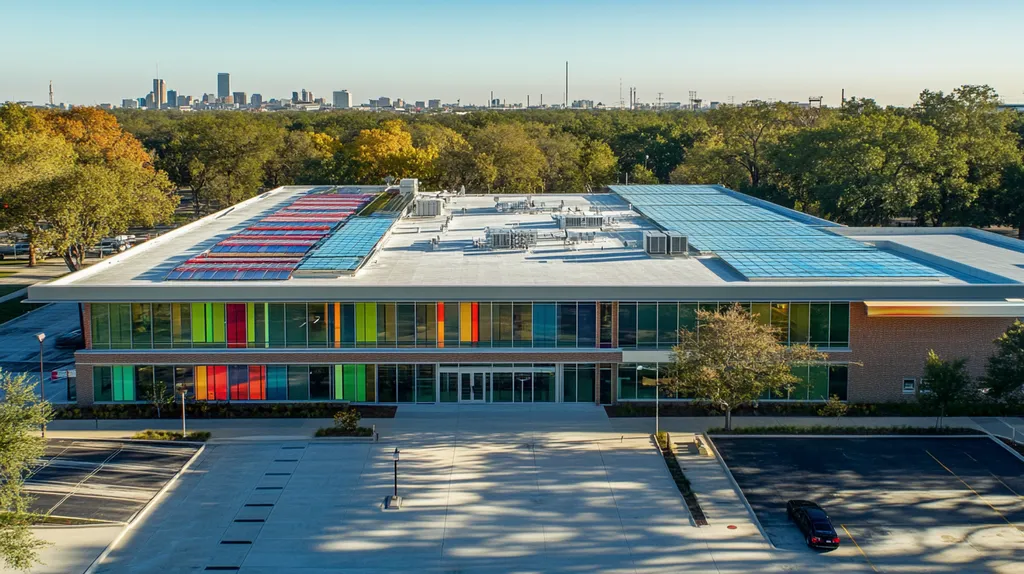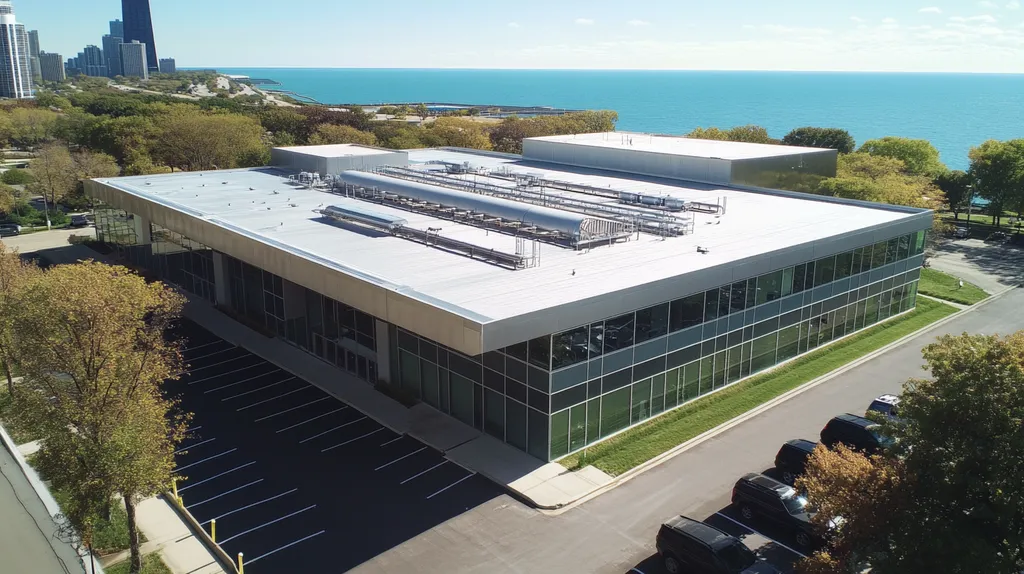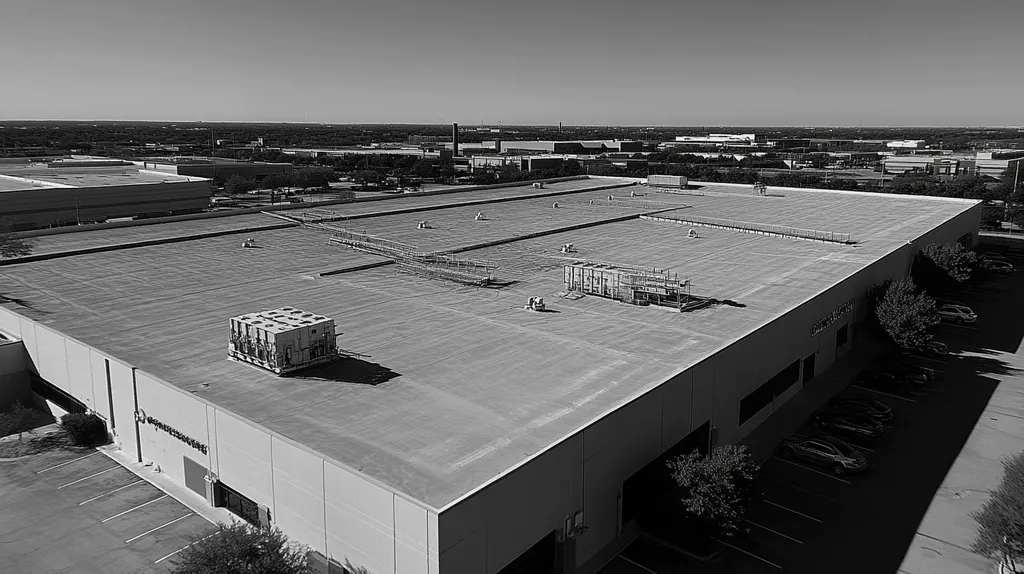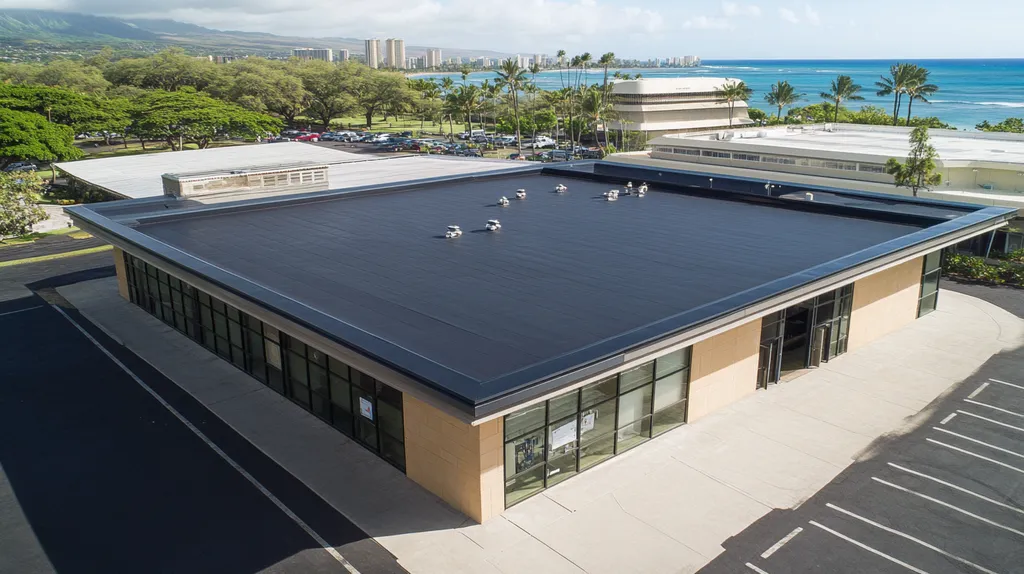Industrial roofing systems account for nearly 40% of commercial building energy loss, costing facility owners millions in wasted utilities while contributing to rising carbon emissions. With increasing regulatory pressure and soaring energy costs, the need for sustainable roofing solutions has never been more urgent.
This comprehensive guide provides facility managers and property owners with actionable steps to transform industrial roofs from energy liabilities into sustainable assets. From material selection and performance metrics to compliance requirements and operational procedures, each section offers practical solutions for improving environmental impact.
By implementing these evidence-based strategies, facilities can reduce energy costs by up to 30% while meeting increasingly stringent environmental standards.
SECTION 1: PERFORMANCE FACTORS
The impact of industrial roofing on the environment is a significant issue for property owners and facility managers alike. Approximately 30% of a building’s total energy usage is attributed to its roofing materials and the effectiveness of its insulation. By making wise choices regarding material selection and insulation standards, stakeholders can boost energy efficiency and cut down their carbon emissions. This section outlines essential performance factors that contribute to the sustainability of industrial roofs.
Material Selection for Energy Efficiency and Reflectivity
Choosing the right roofing materials is vital for enhancing energy efficiency. Reflective roofing options, often referred to as “cool roofs,” help minimize heat absorption and lower cooling expenses. For example, membranes with a high Solar Reflectance Index (SRI) can keep indoor temperatures stable, thereby reducing the need for air conditioning.
Materials such as thermoplastic polyolefin (TPO) and ethylene propylene diene monomer (EPDM) are becoming popular due to their durability and reflective properties. These eco-friendly choices offer substantial energy savings compared to traditional materials, significantly reducing environmental impact.
Climate conditions should also play a role in material selection. In warmer regions, using materials with high reflectivity is crucial for maintaining energy efficiency, while colder climates may need different approaches to optimize thermal performance.
Key Action Items
Achieving Insulation R-Value Targets
The R-value of roofing insulation indicates its effectiveness at resisting heat flow. A higher R-value results in better thermal performance and improved energy efficiency. For most climates, roofs should maintain a minimum R-value of 30 to effectively reduce heating and cooling expenses.
Combining insulation materials—such as rigid board insulation with closed-cell spray foam—can more efficiently meet R-value targets. It’s also critical to choose products that retain their R-value over time, ensuring long-lasting energy efficiency.
Enhancing insulation not only elevates energy efficiency but also improves the comfort of building occupants. A reduction in energy demand positively contributes to a facility’s carbon footprint.
Key Action Items
Membrane Durability and Fire Resistance Standards
Durability and fire resistance are paramount for industrial roofing membranes, especially in areas exposed to severe weather or fire risks. Choosing membranes with high durability can prolong the roof’s lifespan while ensuring compliance with fire-rated standards.
Materials like reinforced PVC or TPO membranes not only offer excellent leak protection but can also endure UV exposure and extreme temperatures. Compliance with fire resistance regulations is essential for mitigating fire hazards in industrial environments.
Moreover, regular maintenance is crucial in maximizing the longevity of roofing systems. Conducting routine inspections and timely repairs can prevent minor issues from escalating, ensuring ongoing compliance with regulations.
Key Action Items
SECTION 2: FINANCIAL CONSIDERATIONS
As industrial facilities increasingly prioritize sustainability, understanding the associated financial implications is crucial. Property owners should recognize that while the initial investment in sustainable roofing solutions may seem high, the long-term savings can be substantial. In fact, a well-implemented green roofing project can reduce energy costs by as much as 25%. Assessing life-cycle costs and budget requirements is essential for balancing both the financial and environmental impacts of roofing decisions.
Life-Cycle Cost Analysis and ROI Projections
To grasp the complete financial impact of different roofing options, conducting a life-cycle cost analysis is imperative. This analysis evaluates initial investments, ongoing maintenance expenses, and potential energy savings throughout the lifespan of the roof. Traditional roofing systems may appear more affordable initially, but they often entail greater ongoing maintenance and energy bills.
Sustainable roofing alternatives, such as cool roofs or green roofs, may require a higher upfront investment but can yield significant savings in energy consumption and maintenance costs. Over time, these roofs can provide an attractive return on investment (ROI), effectively balancing out initial expenditures.
It’s important to factor in potential property value increases as well. Energy-efficient roofs not only lower operational costs but also appeal to tenants seeking environmentally responsible spaces, enhancing marketability.
Key Action Items
Recycling Program Savings and Tax Incentives
Implementing recycling programs for roofing materials can significantly diminish waste and create financial benefits. Many states support initiatives that encourage recycling, offering tax incentives and credits for businesses that recycle materials during roof replacements. This can substantially offset costs related to new installations.
For instance, recycling old roofing materials like metal and asphalt during a roof replacement can lead to considerable savings, and in some cases, these recyclable components can even be sold, further enhancing financial gains. This practice not only addresses environmental concerns but also supports the facility’s financial well-being.
In addition, tax incentives can alleviate the financial strain of upgrading to sustainable roofing solutions. Facilities that install solar or green roofs may qualify for federal or state tax deductions, making these eco-friendly options more financially accessible.
Key Action Items
Budgeting for Sustainable Material Upgrades
When budgeting for sustainable roofing materials, property owners should embrace a strategic approach. It’s crucial to understand that investing in high-quality materials can lead to long-term savings, thus justifying the higher initial costs. For example, although TPO and EPDM roofs may require a larger upfront investment, their durability and energy efficiency can result in reduced maintenance and extended lifespans.
Additionally, sourcing locally produced sustainable materials can decrease transportation expenses and foster community relationships. Investing in sustainable options also showcases a commitment to environmental stewardship, bolstering the company’s reputation.
Facility managers should consider potential savings stemming from improved energy efficiency and minimized waste during budget planning. A transparent budgeting process allows organizations to pinpoint areas where sustainable practices can yield financial benefits, promoting a culture of sustainability.
Key Action Items
SECTION 3: COMPLIANCE REQUIREMENTS
In the quest for sustainable industrial facilities, compliance with regulations is essential. The landscape of roofing standards is evolving, making it crucial for property owners and facility managers to stay informed. With roofing systems significantly contributing to energy usage, adhering to guidelines is not just about legality—it’s about achieving meaningful sustainability goals.
Meeting Energy Star and NSF/ANSI 347 Standards
Energy Star and NSF/ANSI 347 standards are crucial benchmarks for energy-efficient roofing materials. Energy Star certification signifies products that meet strict guidelines, offering the potential for energy savings of up to 30% for industrial facilities. This compliance is not just beneficial for the environment but also translates into financial gains.
NSF/ANSI 347 focuses on sustainability in roofing products by mandating transparency about environmental impacts, including sourcing and lifecycle effects. Opting for roofing materials that align with these standards elevates a facility’s status as an environmentally responsible organization, enhancing its appeal to eco-conscious clients.
Ignorance of these standards can lead to higher operational costs and missed incentives. Property owners and facility managers should actively assess and select roofing options that comply with these essential energy metrics, fostering a culture of environmental stewardship within their operations.
Key Action Items
EPD Documentation and Transparency Requirements
Environmental Product Declarations (EPDs) provide an essential framework for understanding the sustainability of roofing materials. EPDs disclose a product’s environmental impacts throughout its lifecycle, from production to disposal. As sustainability becomes a priority, having these documents readily available is vital for both compliance and informed decision-making.
With rising demands for accountability, many companies must present EPDs for their products. This transparency allows facility managers to make informed choices by comparing materials based on their sustainability credentials. Selecting EPD-verified products helps minimize environmental footprints while ensuring regulatory compliance.
Furthermore, EPDs enable more straightforward product comparisons, driving better purchasing decisions. Ensuring updated EPD documentation is critical not only for compliance but also for maintaining a competitive edge in a market that increasingly values sustainability.
Key Action Items
Local Building Code Alignment for Sustainability
Adhering to local building codes is essential for effective and sustainable roofing strategies in industrial facilities. Many regions are revising their codes to promote green building practices, introducing specific requirements for roofing materials and energy performance. Understanding these codes is vital in avoiding fines and ensuring operational efficiency.
Local codes may demand the use of reflective roofing products or green roofs that enhance energy efficiency and address stormwater management. Aligning with such regulations not only supports sustainability but can also yield significant energy cost reductions.
Failure to adhere to local building codes can result in costly modifications or reworks, hindering sustainability efforts. Engaging with local authorities and collaborating with knowledgeable roofing professionals are critical steps in ensuring compliance with evolving guidelines.
Key Action Items
SECTION 4: RISK MANAGEMENT
Effective risk management is essential for industrial roofing systems that confront various environmental challenges. Research indicates that 40% of commercial roof failures arise from inadequate design or maintenance, resulting in expensive repairs and potential safety risks. By proactively addressing these vulnerabilities, property owners can extend the lifespan of roofs, enhance energy efficiency, and safeguard their investments. This section delves into critical areas of focus: mitigating ponding water and structural stress, ensuring wind uplift resistance, and minimizing fire risks through appropriate membrane selection.
Mitigating Ponding Water and Structural Stress
Ponding water represents a serious threat to the integrity of industrial roofs. When water pools, it adds excess weight that can cause structural stress and even roof collapse. Regular inspections and the installation of efficient drainage systems are vital to combat this issue.
Implementing tapered insulation systems can significantly improve water runoff. A properly sloped roof directs water toward drainage points, thus reducing standing water and extending the roof’s lifespan.
Additionally, keeping gutters and downspouts clear ensures effective drainage. Scheduling routine maintenance after heavy rainfall can eliminate debris that could lead to clogs and subsequent ponding.
Investing in high-quality materials with moisture-resistant properties further mitigates the risks linked to water accumulation. These materials are designed to withstand water exposure, which enhances overall roof stability.
Key Action Items
Wind Uplift Resistance and Storm Preparedness
Wind uplift poses a significant risk for industrial facilities, especially in storm-prone regions. Poorly designed roofs can incur substantial damage during adverse weather, resulting in costly repairs and unsafe conditions. Selecting roofing systems engineered to withstand high winds is critical.
Using suitable fasteners and adhesives is essential for enhancing wind uplift resistance. For instance, a fully adhered membrane system offers better stability during strong gusts of wind.
Conducting wind load calculations during the initial design phase ensures specifications meet local conditions. Knowing the local wind speeds helps property owners select the appropriate materials and installation methods.
Creating a storm preparedness plan is another key step. Regular inspections before storms and having emergency repair contacts available can reduce risk and facilitate quick responses to weather-related damages.
Key Action Items
Fire Risk Reduction Through Membrane Selection
Fire risk is a critical consideration that can have catastrophic effects on industrial properties. Choosing the right roofing membrane is essential to minimizing this hazard. Certain materials boast superior fire resistance, offering vital protection during emergencies.
For instance, membranes made from thermoplastic materials like TPO or PVC are inherently fire-resistant, significantly decreasing fire hazards. Including fire-rated insulation systems can further bolster safety by providing extra fire protection.
Routine maintenance is crucial to reduce fire risks. Regularly removing debris and checking rooftop equipment for potential ignition sources is an essential part of this maintenance.
Moreover, implementing fire safety protocols and providing training for facility staff enhances overall safety culture. Being proactive about fire risks can safeguard lives, property, and financial assets.
Key Action Items
SECTION 5: OPERATIONAL PROCEDURES
To enhance the sustainability of industrial roofs, effective operational procedures are essential. Without proper management, issues like debris accumulation can obstruct drainage systems, leading to harmful water pooling and accelerating roof deterioration. By prioritizing debris management, rigorous inspection protocols, and recycling initiatives, facilities can ensure their roofs work harmoniously with the environment.
Debris Management and Drainage Maintenance
Proper debris management is vital for the durability of industrial roofs. If debris builds up, it can clog drainage systems and increase the likelihood of water damage or structural failure. Regular cleanouts are crucial for facilitating proper water flow and prolonging roof life.
Implementing a strategic debris management plan involves designating debris collection areas, establishing routine inspections, and training maintenance teams on effective practices. Ensuring all staff members are informed about debris management is essential for achieving sustainability goals.
In addition, incorporating biophilic design elements, such as green roofs, can naturally enhance drainage and reduce debris build-up. These features not only aid in rainwater capture and filtration but also promote biodiversity on-site. Post-storm evaluations further help facilities assess drainage effectiveness and adjust maintenance strategies as needed.
Key Action Items
Roof Inspection Protocols for Sustainability Metrics
Regular inspections are crucial to maintaining industrial roofs. Establishing clear inspection protocols ensures sustainability metrics are consistently tracked. These assessments help identify current issues and preemptively address potential future problems.
During inspections, teams should examine various elements, including membrane conditions, drainage efficiency, and insulation effectiveness. Gathering comprehensive data enables facilities to measure performance against sustainability standards and highlight areas needing improvement.
Utilizing technologies such as drones or thermal imaging can improve traditional inspection methods, providing in-depth evaluations while minimizing safety risks. Additionally, creating a digital database for inspection results offers valuable insights into historical roof performance, guiding future resource allocation for sustainability enhancements.
Key Action Items
Membrane Repair and Recycling Take-Back Processes
As industrial roofs age, timely repairs to membrane systems are essential for preserving their integrity. Implementing a proactive repair timetable prevents minor issues from escalating into costly repairs, supporting the roof’s lifespan and environmental sustainability.
Additionally, integrating recycling take-back initiatives for roofing materials is crucial. Many manufacturers offer programs for returning used membranes to be recycled, significantly reducing waste. Facilities should prioritize suppliers committed to sustainable practices and responsible disposal methods.
Training maintenance teams in effective repair techniques promotes operational resilience. For example, teaching minor repair strategies, such as patching and seam sealing, empowers staff to handle small issues without relying on external contractors. Raising awareness around the sustainability of roofing materials can also influence decisions for future projects.
Key Action Items
SECTION 5: OPERATIONAL PROCEDURES
Implementing effective operational procedures is crucial for boosting the sustainability of industrial roofs. Neglecting proper management can lead to problems like debris accumulation, which clogs drainage systems and causes damaging water pooling. By prioritizing debris management, thorough inspection protocols, and recycling initiatives, facilities can ensure their roofs positively impact the environment.
Debris Management and Drainage Maintenance
Efficient debris management is essential for prolonging the life of industrial roofs. When debris piles up, it can block drainage systems, increasing the risk of water damage and potential structural failure. Regular cleanouts are critical to maintaining proper water flow and enhancing the roof’s durability.
A systematic approach to managing rooftop debris can significantly help. This plan may include designating specific areas for debris collection, scheduling periodic cleanouts, and training maintenance staff on effective management practices. Ensuring that all team members are on the same page is crucial for achieving sustainable operations.
Additionally, biophilic design elements, like green roofs, can promote natural drainage and minimize debris build-up. These features not only improve rainwater capture and filtration but also contribute to local biodiversity. Conducting evaluations after storms can provide insights into drainage performance, helping facilities improve their maintenance strategies over time.
Key Action Items
Roof Inspection Protocols for Sustainability Metrics
Conducting regular roof inspections is key to ensuring their health and efficiency. Clear protocols for these inspections ensure that sustainability metrics are consistently monitored and evaluated. This process helps identify existing problems and address potential future issues before they escalate.
Inspection teams should examine various aspects of roof performance, including membrane condition, drainage efficiency, and insulation effectiveness. Detailed data collection will allow facilities to measure their roofs against sustainability benchmarks, highlighting areas in need of improvement.
Utilizing advanced technologies, such as drones or thermal imaging, can enhance traditional inspection methods. These tools facilitate thorough assessments while minimizing safety risks, offering a comprehensive overview of the roof’s condition. Maintaining a database of inspection results contributes to informed decision-making and resource allocation.
Key Action Items
Membrane Repair and Recycling Take-Back Processes
Timely repairs of roofing membranes are critical for maintaining structural integrity as roofs age. Establishing a proactive repair schedule will ensure smaller issues are addressed before escalating into costly repairs, thus maximizing the roof’s lifespan and contributing to sustainability.
Incorporating recycling initiatives for used membrane materials can further enhance sustainability. Many manufacturers provide take-back programs to recycle old membranes, which helps reduce landfill waste. Facilities should seek out suppliers committed to sustainable recycling and responsible disposal practices.
Training maintenance teams in effective repair techniques fosters resilience. Empowering staff with skills such as patching and seam sealing enables them to handle minor issues efficiently, reducing reliance on external contractors. Raising awareness regarding the importance of sustainable materials encourages better choices in future roofing projects.
Key Action Items
Moving Forward
With industrial roofing accounting for nearly 40% of commercial building energy loss and stringent environmental regulations on the horizon, the time for sustainable roofing solutions is now.
Through strategic material selection, enhanced insulation practices, and proper maintenance protocols, facilities can reduce energy costs by up to 30% while significantly decreasing their carbon footprint.
The integration of EPD documentation, recycling programs, and comprehensive risk management strategies ensures compliance while generating substantial ROI.
As extreme weather events become more frequent and energy costs continue to rise, investing in sustainable roofing solutions is no longer optional – it’s a critical business imperative for industrial facilities seeking long-term operational resilience and environmental responsibility.
The future of industrial roofing lies in embracing these sustainable practices, not just for environmental benefit, but for significant operational and financial advantages.
FREQUENTLY ASKED QUESTIONS
Q. How does material selection affect commercial roof energy efficiency?
A. Choosing the right materials is essential for energy efficiency in roofing. Specific reflective options can minimize heat absorption, lowering cooling costs. Selecting durable membranes like TPO or EPDM also contributes to energy savings and sustainability.
Q. What financial benefits can industrial roof upgrades provide?
A. Sustainable roofing solutions can offer significant long-term financial benefits. Although the initial investment may be higher, savings on energy costs and maintenance can be substantial. These upgrades can also enhance property values, making them financially advantageous.
Q. How do local building codes impact industrial roof sustainability?
A. Compliance with local building codes is essential for sustainability in roofing. These regulations may mandate the use of energy-efficient materials or designs that enhance water management. Adhering to these codes can avoid fines and improve operational efficiency.
Q. What are common risks associated with industrial roofing systems?
A. Risks include structural failures due to inadequate design, water pooling, and wind uplift. Regular maintenance and inspections can mitigate these issues. It’s also essential to choose materials that offer fire resistance to enhance safety and longevity.
Q. How important is debris management for industrial roofs?
A. Debris management is crucial for maintaining roof integrity. Accumulated debris can block drainage systems, leading to water damage. Implementing regular cleanouts and strategic debris management plans can prolong roof lifespan and boost sustainability.
Q. What role do fire-resistant membranes play in industrial roofing?
A. Fire-resistant membranes are essential in minimizing risk to industrial properties. These materials significantly reduce fire hazards and improve safety during emergencies. Regular maintenance and inspections of these membranes are vital to ensure continued effectiveness.
Q. How can facility managers enhance roof sustainability?
A. Facility managers can enhance sustainability by implementing regular inspections, choosing eco-friendly materials, and practicing effective maintenance. Establishing recycling programs for materials and creating an awareness culture among staff also significantly boosts roofing sustainability.

